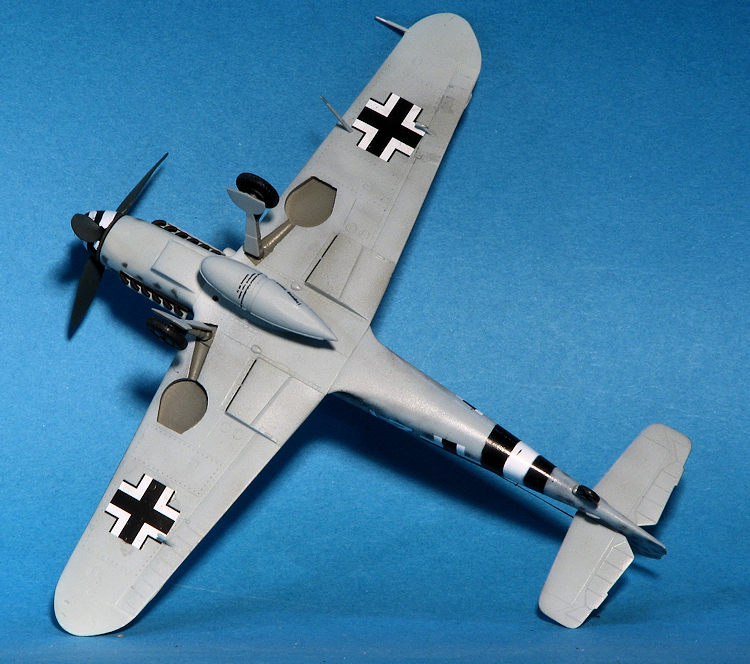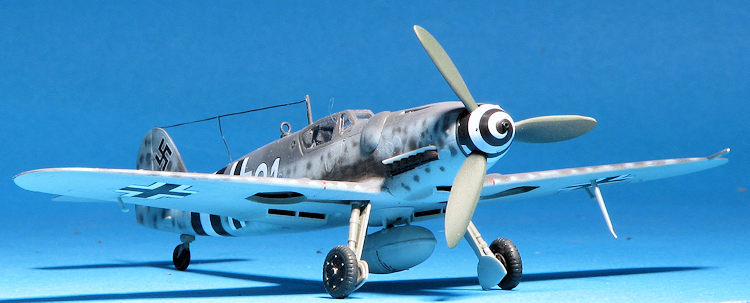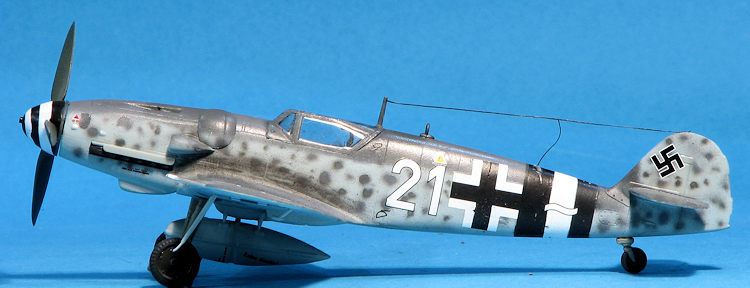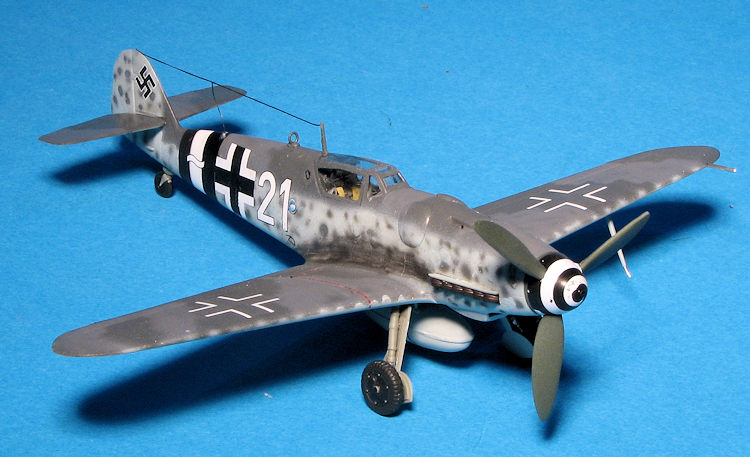
Academy 1/72 Bf-109G-14
| KIT #: | 1653 |
| PRICE: | $6.95 when new |
| DECALS: | Two options |
| REVIEWER: | Scott Van Aken |
| NOTES: | 2001 boxing |

| HISTORY |
The G-14 arrived in July 1944 at the invasion front over
France. It represented an attempt to create a standard type, incorporating many
changes which had been introduced during production of the G-6, and which led to
a plethora of variants, plaguing decentralized mass production. The
standardization attempt proved to be a failure, but overall the type offered
improved combat performance, as MW 50 power boosting water injection (increasing
output to 1,800 PS (1,775 hp, 1,324 kW), the clear-view Erla
 Haube was now
standard installation. Top speed was 568 km/h (353 mph) at sea level, and
665 km/h (413 mph) at 5 km (16,400 ft) altitude. A high-altitude fighter,
designated G-14/AS was also produced with the DB 605ASM high-altitude engine.
The ASM engine was built with a larger capacity supercharger, and had a higher
rated altitude, and correspondingly the top speed of the G-14/AS was 560 km/h
(348 mph) at sea level, and 680 km/h (422 mph) at 7,5 km (24,600 ft) altitude.
There was increasing tendency to use plywood on some less vital parts e.g. on a
taller tailfin/rudder unit, pilot seat or instrument panel. A cautious estimate
based on the available records suggest that about 5,500 G-14s and G-14/AS were
built.
Haube was now
standard installation. Top speed was 568 km/h (353 mph) at sea level, and
665 km/h (413 mph) at 5 km (16,400 ft) altitude. A high-altitude fighter,
designated G-14/AS was also produced with the DB 605ASM high-altitude engine.
The ASM engine was built with a larger capacity supercharger, and had a higher
rated altitude, and correspondingly the top speed of the G-14/AS was 560 km/h
(348 mph) at sea level, and 680 km/h (422 mph) at 7,5 km (24,600 ft) altitude.
There was increasing tendency to use plywood on some less vital parts e.g. on a
taller tailfin/rudder unit, pilot seat or instrument panel. A cautious estimate
based on the available records suggest that about 5,500 G-14s and G-14/AS were
built.
The following variants of the G-14 were produced:
| THE KIT |
Not
that many G-14 kits have been produced in 1/72 scale. The earliest is probably
what Heller boxed as a 109K, and more recently, Hasegawa and Fine Molds have
done this version. Academy broke no new ground on this one, choosing to go with
the separate tail section as is often the case with newer 109 kits. This allows
the fuselage to be used for a number of similar variants.
kits. This allows
the fuselage to be used for a number of similar variants.
For a cockpit, you get a floor with rear bulkhead, some inner fuselage detail along with a separate stick and seat. There are rudder pedal shapes molded on the floor and a box in front of the seat that is supposed to be the cannon breech housing. The kit does provide a separate instrument panel and trim wheels for the fuselage interior.
The upper fuselage breech bulges are separate as is the upper cowling deck itself. Exhaust and their shields are installed from the outside, which I like. Landing gear legs and gear doors are separate as are the one piece main wheels. The kit includes the Morane antenna and aileron mass balances. There is a drop tank rack and the choice of two tank designs. The kit includes a separate windscreen and canopy. A section of head armor is provided to place inside the Erla Haube canopy. There is no radio mast but there is a DF loop antenna. The prop is a single piece that fits into a two piece spinner/backing plate.
Instructions are well done with painting information in generic and RLM color shades. Markings are provided for two planes. One is the all white box art aircraft with yellow lower cowling and fuselage band painted in overall white uppers and RLM 76 undersides. This is apparently Erich Hartmann's plane with JG 53 in Feb of 1945 in Hungary. The other is a JG 11 plane from early 1945 in Germany. It is shown as painted in RLM 74/75/76 with a yellow fuselage band. There is a spiral for the spinner and a yellow band also covers the very forward nose behind the spinner. The decal sheet is nicely done, but does not include the swastika.
My kit was sent to me direct from Korea about a dozen years back so still includes the small tube of glue.
| CONSTRUCTION |
 First step is to open up various holes. There are those in the wing for the
centerline rack and the antenna. One could also do the wing cannon, but I'm
not sure how many G-1s actually had this option so I left them closed. The
instructions do not show them being used. I also assembled the cockpit
floor, seat and control stick. This kit comes with a separate tail section
and while the instructions showed this being first completely built prior to
attaching, I decided to attach each side to the fuselage half first.
First step is to open up various holes. There are those in the wing for the
centerline rack and the antenna. One could also do the wing cannon, but I'm
not sure how many G-1s actually had this option so I left them closed. The
instructions do not show them being used. I also assembled the cockpit
floor, seat and control stick. This kit comes with a separate tail section
and while the instructions showed this being first completely built prior to
attaching, I decided to attach each side to the fuselage half first.  he fuselage halves were put together. One has to be careful during this as
the interior makes fitting them a bit difficult. I had no issues with the
'pre-attached' tail sections. The wings had already been assembled and those
were attached. Fit of the wings is excellent. Same goes for the tailplanes
which have tabs of different sizes so you will not install them reversed.
These pieces look a bit too square on the end to me.
he fuselage halves were put together. One has to be careful during this as
the interior makes fitting them a bit difficult. I had no issues with the
'pre-attached' tail sections. The wings had already been assembled and those
were attached. Fit of the wings is excellent. Same goes for the tailplanes
which have tabs of different sizes so you will not install them reversed.
These pieces look a bit too square on the end to me. | COLORS & MARKINGS |
 pper
colors. Since the sheet does not come with the black/white/black Reich
Defense band, I had to paint it on. I truly suck at doing these sorts of
thing, but got it to where it was acceptable.
pper
colors. Since the sheet does not come with the black/white/black Reich
Defense band, I had to paint it on. I truly suck at doing these sorts of
thing, but got it to where it was acceptable. | CONCLUSIONS |
 Despite the
kit looking a bit odd in some places (tailplanes and the lower cowling), it
still looks very much like a 109G-14. It really is not that difficult a build
and the fit is quite good though it doesn't hurt to do some test fitting to be
sure. I am not sure if this has been surpassed by the recent AZ Models kits, but
it is not expensive and worth picking up.
Despite the
kit looking a bit odd in some places (tailplanes and the lower cowling), it
still looks very much like a 109G-14. It really is not that difficult a build
and the fit is quite good though it doesn't hurt to do some test fitting to be
sure. I am not sure if this has been surpassed by the recent AZ Models kits, but
it is not expensive and worth picking up.
| REFERENCES |
http://en.wikipedia.org/wiki/Messerschmitt_Bf_109_variants
9 December 2016
Copyright ModelingMadness.com. All rights reserved.
Thanks to me for the preview kit. If you would like your product reviewed fairly and fairly quickly, please
contact
the editor or see other details in the
Note to
Contributors.